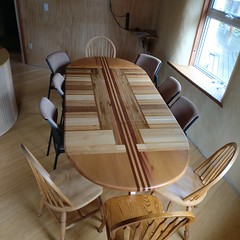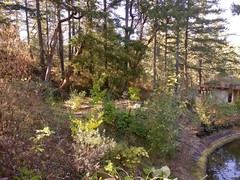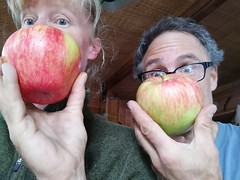I finally got my garlic planted, 350 Hazelnut trees have arrived in the nursery, the puppy is sleeping, municipal elections are over, goats are milked, it’s raining finally, and Gord is on a job site today…so I can sit down and write a quick blog post.
Nina Died
Our amazingly special Nina dog has died. It was a gut wrenching shock for us both to have to make the final decision of her life with virtually no warning. She basically collapsed one evening after a council meeting and in the middle of the night, after an emergency scan, we learned that fluid had built up around her heart…ironically just like our last dog Boo. Apparently there was also a mass on her heart likely causing the fluid build up. We brought her home and buried her right out front and had our own special ceremony. We are becoming more acquainted with death and felt gratitude for sharing 7 years with this special being.
Municipal Campaign
Nina’s death occurred right at the beginning of a very busy election time. Our campaign was filled with learning, listening, reflection, collaboration, excitement, and the ever-present uncertainty of what the results will be. The good news is that both of us were easily re-elected…the bad news is that Gord received 8 more votes that me.
Garden
The campaign took a lot of time and energy, so we really have not spent much time in the garden or nursery, and also got behind in some fall food processing and harvesting. However, because of the incredibly long fall and seemingly never ending summer, we got some extra time to catch up.
I just got the last of my 320 garlic planted in four different garden beds. Still have to harvest fuzzy kiwi, and persimmons.
This past garden year was different…very different. Very poor pollination of apples, pears, and plums due to the wet cold spring, still no walnuts, and only one chestnut. But for every crop that fails, we have crops that thrive. Perennial veggies thrived, as did olives, broccoli and cauliflower. Our root veggies kicked butt this year. Hazelnuts are proving to be rock solid for us.
Cats
Our tiny cats Stormy and Sparky are thriving and bring us a rodent most days. They are truly amazing little hunters that fill us with such joy and gratitude for their gifts, cuddles, and cat antics. Our gardens are safe from excessive rodent predation but yes we still do some sharing…especially with the abundant bird population thriving on this land. Since we embarked on the re-wilding of this land with human created food systems, we have actually put the system out of balance. More intense food availability means more creatures eating it…which means denser populations of birds and rodents can be supported. Adding two cats who mostly hunt rodents, yet still kill a few birds does not negatively harm the ecosystem overall…in fact adding predators into the system can help bring a system like ours back into balance.
Goats
Our goats, Dabha and Gemma are thriving with all the goat food growing here in the food forest and the annual gardens. Too much zucchini is impossible. Sometimes we take them to the food on a leash, and sometimes we bring the food to them. Our goats eat about half the amount of hay that they would otherwise eat without the food inputs from this land. We no longer have to bring in outside inputs (manure or mulch).
Dabha’s milk production has slowed whey down, so it was time for a trip to my neighbours for servicing by her buck Giordie. Dabha was clearly in heat with lots of tail wagging, calling, and frisky behaviour and Giordie did not disappoint. It was love at first sight with lots of kissing, nibbling, nuzzling, and frisky fore play. Success…we think. Due date is March 5th if all goes well.
Hazelnuts have arrived in the Nursery
Woohoo, it’s time to go nuts. Hazelnuts have become a food security tree for us on so many levels. The trees grow fast and produce lots of nuts in a very short number of years. The leaves are a goat favourite and the trees are very generous producers. Hazelnuts are also used successfully in grey water systems. Roots of hazelnuts produce thick carbon sequestering mats. Yes, squirrels do eat the nuts, but they also plant more trees everywhere. The invasive grey squirrel is also good eating if you are so inclined. The little native brown squirrel gets to eat all the nuts they desire. We are grateful to the generous hazelnut tree and Nina, Stormy, and Sparky for alerting us to squirrels.
We bulk ordered 350 EFB resistant hazelnuts so that we can offer a really good price in the nursery. Most trees are $35 with only “Dorris” being offered at $40. Includes GST. All in 1 gallon pots. We prefer to sell these in groups of three or four for the best pollination.
Option 1: Dorris, Yamhill, Theta for $110
Option 2: Jefferson, Yamhill, Theta (or Gamma or Eta) for $105
Option 3 (four trees): Dorris, Jefferson, Yamhill, Theta (or Gamma or Eta) for $145
Please enquire with us for options for 5 or more trees.
All sales are by private appointment. Full Inventory list is here:
Please email at ann@eco-sense.ca
Pumpkin, our new puppy.
So with Nina now pushing up daisies in our front yard, we open our hearts again to a new love. Pumpkin Pie Baird is our new rescue mutt. She came into our hearts on Halloween at the age of 8 weeks. She will likely be a mid sized dog just like her mom Joni. They both look like Huskies. She’s smart, affectionate, busy, and full of love and cuddles. She is being partly raised by cats and has already learned how to hunt rats with the cats, hide in boxes, and vocalize and swat like a cat. Part of the team! Pumpkin Storms are common around here with hours of play…the best being when Stormy hides in the paper bag and pumpkin pulls her around and then sits on her.
Vaccines
Humans are in OVERSHOOT. I don’t think there would be a population biologist in the world that would disagree with this statement. If you disagree with this statement I would suggest you hit the textbooks or skip this section.
When any population, (whether it be rats, monocultures, bacteria in a petri dish, or humans), exceeds the carrying capacity of the environment, nature will re-balance the population with built in systems like disease and pests.
In our current human situation we long ago reached this OVERSHOOT point but we put our smart brains to work and figured out how to expand into new more hostile environments with less easy resources. But humanity still didn’t take the hint with scarce resources and further utilized our amazing technologies to grow more food and extract even more energy from the earth…with great costs to the atmosphere, the soil, the air, and the oceans.
Humanity has now reached EIGHT BILLION PEOPLE and there is not enough habitat or resources left on planet earth for all the other living beings to exist. It’s not simply about “fixing” climate change or sharing resources more equally amongst the 8,000,000,000 people, it’s about how much of the earth is covered in our bodies and absorbing our wastes. We are large mammals…there’s only so much space on planet earth for large mammals…PERIOD. This is precisely why in the last 50 years the earth has LOST 50% of the wildlife.
Which brings me to vaccines…and Covid, and viruses, and any disease really. This is what nature does when a population is in OVERSHOOT. But yet the human brain kicks in again and creates vaccines to protect people from disease. Vaccines work. Do I want a disease? NO! Do I want my family and friends or community to get sick? NO! Do I want anyone to suffer? NO!
So yes, Gord and I are fully vaccinated and we urge others to get vaccinated too. But isn’t this a contradiction that will allow humanity to go even further into OVERSHOOT by using vaccine technology? YUP! The basic ecological rule in OVERSHOOT is that the further a population or system goes into OVERSHOOT the harder it will be to rebalance the system…but the system WILL rebalance.
No time to get depressed however, there is much we can do to help nature rebalance HUMAN OVERSHOOT in a more ethical controlled way. De-growth will occur, but humanity can still have a say as to how that will happen. Will it happen with war, scarcity, and disease, or will it happen with love, sharing, global family planning, education, equity, compassion, and re-wilding the earth? Here’s an essay to read or listen to by Robin Wall Kimmerer on “An Economy of Abundance”. https://emergencemagazine.org/essay/the-serviceberry/
Gord is currently experiencing his own personal OVERSHOOT and he knows that he must slow down before his health suffers. We all know it’s much better to be proactive in these situations. Gord will be taking the next few months to catch up on some of his work commitments while saying no to some interesting opportunities that come his way. He loves his work…but there’s only one Gord. Personal de-growth in productivity balanced with growth in Well-Being.
Solar PV
No, we don’t think solar is going to save the world from OVERSHOOT…only de-growth in a cooperative nature-based relocalized economy can perhaps help. But electrifying our energy grid is a small piece. For us our solar and other food, water, and waste systems certainly bring more resilience.

Our first goal was to reduce our use of burning firewood and propane (GHGs). So we looked into a heat pump. But with our current heating infrastructure it seemed very inefficient…not to mention the use of more climate damaging refrigerants. There is heat pump technology that uses CO2 as the refrigerant and heats hot water. This would tie in beautifully to our existing high temperature in floor heating system that ties in with our solar hot water. This would be a sweet system indeed…but sadly is not yet doable unless we purchase a new separate industrial system rather than tie into our existing solar boiler. To make a long story short, we are going to supplement our heating requirements with our electric element in our solar boiler. Simple and with the least amount of new infrastructure.
By swapping out our sixteen 170W solar PV panels with twelve newer 480W panels we more than double our PV output and can heat our home, charge our ebikes, and use electricity for cooking rather than propane. With the costs of all forms of combustion based energy rising this makes the most ecological and economical sense for us. Firewood this year was $500 a cord!
We will be selling our sixteen 170W panels along with two Outback MX60 charge controllers sometime in Feb. Please contact us with enquiries.
Thanks,
Ann and Gord



































